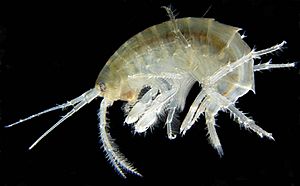Amphipod facts for kids
Quick facts for kids AmphipodaTemporal range: Eocene to Recent
|
|
|---|---|
 |
|
| Gammarus roeseli | |
| Scientific classification | |
| Kingdom: | |
| Phylum: | |
| Subphylum: | |
| Class: | |
| Superorder: |
Peracarida
|
| Order: |
Amphipoda
Latreille 1816
|
| Suborders | |
|
|
Amphipods are a type of small crustacean. They are related to crabs, lobsters, and shrimp. You can find them in almost all water environments. They live in the ocean, in fresh water, and even on land!
The name amphipoda means "different-footed." This is because they have many different kinds of legs. Unlike some other crustaceans, their legs are not all the same.
There are over 7,000 known species of amphipods. Most of them belong to a group called Gammaridea.
Amphipods can be very tiny, about 0.1 centimeters (0.04 inches) long. But some can grow quite large, up to 34 centimeters (13 inches)! Most amphipods eat tiny bits of dead plants and animals. Some are also scavengers, eating what they find.
They live in many places. About 750 species live in caves. Some amphipods are terrestrial animals, like sandhoppers. The largest amphipods live deep down on the sea floor. They can be found seven kilometers (about 4.3 miles) deep!
How Amphipods Reproduce
Female amphipods have a special pouch called a marsupium. This pouch holds her eggs. The eggs are fertilised inside this pouch. They stay there until the young amphipods are ready to hatch.
As a female gets older, she can produce more eggs in each group. About 25% to 50% of the eggs might not survive. When the eggs hatch, they come out as tiny versions of the adults. There is no larval stage. Young amphipods usually become adults after they have molted six times. Molting means shedding their outer skin to grow bigger.
Images for kids
-
Talitrus saltator is an abundant animal of sandy beaches around Europe.
-
Dorsal (top) view of a newly discovered amphipod living in a commensal relationship with a bamboo coral
See also
 In Spanish: Anfípodos para niños
In Spanish: Anfípodos para niños








